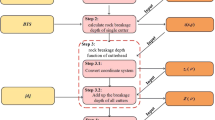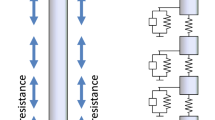Abstract
Based on the BP neural network model of machine learning method, the corresponding random input parameters are generated by Monte Carlo method, and the prediction of TBM driving speed is studied. In this study, the machine learning method is applied to the prediction of TBM penetration rate, and the established empirical model has higher accuracy and practicability. After selecting the predictive control type of BP neural network, according to the control requirements of TBM, system composition and the characteristics of different geological tunneling, the appropriate data are selected to train the neural network, and the predictive control model of neural network for TBM with high convergence and real-time performance is established. Monte Carlo method has strong optimization and control functions in the realistic planning of many complex problems. In the process of TBM velocity prediction, the random input of parameters is realized by Monte Carlo method, which makes the prediction more accurate. BP neural network is used to predict the penetration rate of TBM. Its accuracy mainly depends on the accuracy of input parameters. The actual measured and predicted values of TBM driving speed are basically near the straight line x = y as the horizontal and vertical coordinates, and the correlation coefficient R = 0.9789. Therefore, the BP neural network combined with genetic algorithm has a high reference value for the prediction of TBM driving speed. When the TBM type is the same and the system equipment is the same, four factors, namely uniaxial compressive strength, Brazilian tensile strength, peak slope index, and distance between planes of weakness, are taken as input parameters of BP network by calculating the weight of influencing factors. In the specific operation, the genetic algorithm is used to iterate continuously to find the optimal solution of the initial weight parameters of BP neural network. In this study, this prediction method is applied to practical prediction. The feasibility of this method is verified by comparing with the final actual measurement result, which is of great practical significance to the evaluation of engineering, design scheme and cost control.








Similar content being viewed by others
Explore related subjects
Discover the latest articles, news and stories from top researchers in related subjects.References
Ghorbani MA, Khatibi R, Fazelifard MH (2016) Short-term wind speed predictions with machine learning techniques. Meteorol Atmos Phys 128(1):57–72
Ji YF, Zhang JW, Shi Z (2018) Research on real- time tracking of table tennis ball based on machine learning with low-speed camera. Syst Sci Control Eng Open Access J 6(1):71–79
Jakubowski J, Stypulkowski JB, Bernardeau FG (2017) Multivariate linear regression and CART regression analysis of TBM performance at Abu Hamour phase-I tunnel. Arch Min Sci 62(4):825–841
Xing H, Liu Q, Kai S (2018) Application and prospect of hard rock TBM for deep roadway construction in coal mines. Tunnel Undergr Space Technol 73:105–126
Stypulkowski JB, Bernardeau FG (2018) Jakubowski J. Descriptive statistical analysis of TBM performance at Abu Hamour Tunnel Phase I. Arab J Geosci 11(9):191
Türkan YS, Aydoğmuş HY, Erdal H (2016) The prediction of the wind speed at different heights by machine learning methods. Int J Optim Control Theor Appl 6(2):179–187
Mcginnis RS, Mahadevan N, Moon Y (2017) A machine learning approach for gait speed estimation using skin-mounted wearable sensors: from healthy controls to individuals with multiple sclerosis. PLoS ONE 12(6):1–16
Jiang H, Zou Y, Zhang S (2016) Short-term speed prediction using remote microwave sensor data: machine learning versus statistical model. Math Probl Eng 1965:1–13
Kiiski H, Jollans L, Donnchadha SÓ (2018) Machine learning EEG to predict cognitive functioning and processing speed over a 2-year period in multiple sclerosis patients and controls. Br Topogr 31(2):1–18
Tseng CM (2013) Speeding violations related to a driver’s social-economic demographics and the most frequent driving purpose in Taiwan’s male population. Saf Sci 57(Complete):236–242
Watling CN, Armstrong KA, Smith SS (2016) Crash risk perception of sleepy driving and its comparisons with drink driving and speeding: which behavior is perceived as the riskiest. Traffic Inj Prev 17(4):400–405
Bogstrand ST, Larsson M, Holtan A (2015) Associations between driving under the influence of alcohol or drugs, speeding and seatbelt use among fatally injured car drivers in Norway. Accid Anal Prev 78:14–19
Wang F, Gou B, Zhang Q (2016) Evaluation of ground settlement in response to shield penetration using numerical and statistical methods: a metro tunnel construction case. Struct Infrastruct Eng 12(9):1024–1037
Zhou C, Ding L, Zhou Y (2019) Hybrid support vector machine optimization model for prediction of energy consumption of cutter head drives in shield tunneling. J Comput Civ Eng 33(3):04019019
Kosciolek T, Jones DT (2016) “Accurate contact predictions using covariation techniques and machine learning. Proteins Struct Funct Bioinform 84:145–151
Falahati F, Westman E, Simmons A (2014) Multivariate data analysis and machine learning in Alzheimer’s disease with a focus on structural magnetic resonance imaging. J Alzheimer’s Dis 41(3):685–708
Yagiz S (2008) Utilizing rock mass properties for predicting TBM performance in hard rock condition. Tunnel Undergr Space Technol 23(3):326–339
Tello G, Al-Jarrah OY, Yoo PD (2018) Deep-structured machine learning model for the recognition of mixed-defect patterns in semiconductor fabrication processes. IEEE Trans Semicond Manuf 31(2):315–322
Installé AJF, Van den Bosch T, De Moor B (2014) Clinical data miner: an electronic case report form system with integrated data preprocessing and machine-learning libraries supporting clinical diagnostic model research. JMIR Med Inform 2(2):e28
Armaghani DJ, Faradonbeh RS, Momeni E (2018) Performance prediction of tunnel boring machine through developing a gene expression programming equation. Eng Comput 34(1):129–141
Caye A, Rocha TBM, Anselmi L (2016) Attention-deficit/hyperactivity disorder trajectories from childhood to young adulthood: evidence from a birth cohort supporting a late-onset syndrome. JAMA Psychiatry 73(7):705–712
Rostami J (2016) Performance prediction of hard rock Tunnel Boring Machines (TBMs) in difficult ground. Tunnel Undergr Space Technol 57:173–182
Hasanpour R, Rostami J, Ünver B (2014) 3D finite difference model for simulation of double shield TBM tunneling in squeezing grounds. Tunnel Undergr Space Technol 40:109–126
Benato A, Oreste P (2015) Prediction of penetration per revolution in TBM tunneling as a function of intact rock and rock mass characteristics. Int J Rock Mech Min Sci 74:119–127
Shirlaw JN (2016) Pressurised TBM tunnelling in mixed face conditions resulting from tropical weathering of igneous rock. Tunnel Undergr Space Technol 57:225–240
Acknowledgement
This paper has been supported by National Natural Science of China (Grant no. 41572358).
Author information
Authors and Affiliations
Corresponding author
Ethics declarations
Conflict of interest
There is no potential conflict of interest in our paper. And all authors have seen the manuscript and approved to submit to your journal. We confirm that the content of the manuscript has not been published or submitted for publication elsewhere.
Additional information
Publisher's Note
Springer Nature remains neutral with regard to jurisdictional claims in published maps and institutional affiliations.
Rights and permissions
About this article
Cite this article
Wei, M., Wang, Z., Wang, X. et al. Prediction of TBM penetration rate based on Monte Carlo-BP neural network. Neural Comput & Applic 33, 603–611 (2021). https://doi.org/10.1007/s00521-020-04993-6
Received:
Accepted:
Published:
Issue Date:
DOI: https://doi.org/10.1007/s00521-020-04993-6




